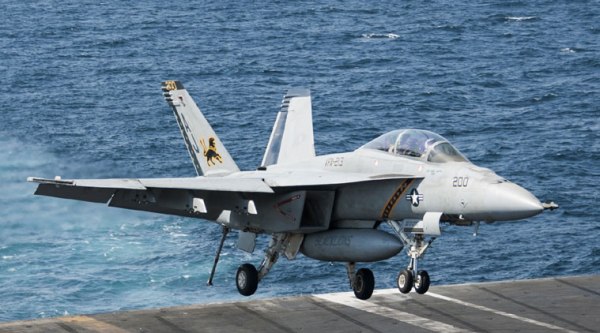Stay updated with the latest - Click here to follow us on Instagram
US spent around $1.1 bn on ops against Islamic State in Syria, Iraq: Pentagon
US Central Command said that the Navy has dropped roughly 185 munitions, including 47 cruise missiles launched from ships in the region.
 In this Tuesday, Sept. 23, 2014 photo released by the U.S. Navy, an F/A-18F Super Hornet, attached to the “Fighting Black Lions” of Strike Fighter Squadron (VFA) 213, lands aboard the aircraft carrier USS George H.W. Bush, which is supporting U.S.-led coalition airstrikes on Islamic State group and other targets in Syria and Iraq. Coalition warplanes bombed oil installations and other facilities in territory controlled by Islamic State militants in eastern Syria on Friday, Sept. 26, 2014. (Source: AP)
In this Tuesday, Sept. 23, 2014 photo released by the U.S. Navy, an F/A-18F Super Hornet, attached to the “Fighting Black Lions” of Strike Fighter Squadron (VFA) 213, lands aboard the aircraft carrier USS George H.W. Bush, which is supporting U.S.-led coalition airstrikes on Islamic State group and other targets in Syria and Iraq. Coalition warplanes bombed oil installations and other facilities in territory controlled by Islamic State militants in eastern Syria on Friday, Sept. 26, 2014. (Source: AP)
The Pentagon has spent as much as $1.1 billion on U.S. military operations against Islamic State militants in Iraq and Syria since the mission began in mid-June, including more than $62 million alone in Navy airstrikes and Tomahawk cruise missiles.
READ: Islamic State wages assault on Syrian border town of Kobani backed by tanks and artillery
U.S. Central Command, in data released Monday, said that the Navy has dropped roughly 185 munitions, including 47 cruise missiles launched from ships in the region. Central Command said Air Force fighter jets have far exceeded those numbers, launching close to 1,000 munitions. The data released Monday broke out the $62 million spent on Navy munitions, but provided no cost estimates for Air Force munitions.
 FILE – In this Sept. 2, 2014, file photo, Pentagon press secretary Navy Rear Adm. John Kirby speaks during a briefing at the Pentagon. (Source: AP)
FILE – In this Sept. 2, 2014, file photo, Pentagon press secretary Navy Rear Adm. John Kirby speaks during a briefing at the Pentagon. (Source: AP)
The bulk of the Navy costs were for the 47 Tomahawk cruise missiles fired by American warships in the Persian Gulf and the Red Sea that targeted the Khorasan Group, an al-Qaida cell, in eight locations west of the city of Aleppo in Syria. The group was said to be plotting imminent attacks on American and Western interests, and it was one of the key targets two weeks ago when the U.S. first began airstrikes into Syria.
READ: American teen arrested for trying to flee US to join ISIS
The Pentagon has struggled to come up with specific cost figures for the Iraq and Syria operations. Officials say it has cost an average of $7 million to $10 million daily since June.
 In this Friday, Sept. 26, 2014 photo, released by the U.S. Air Force, a U.S Air Force KC-10 Extender refuels an F-22 Raptor fighter aircraft prior to strike operations in Syria.(Source: AP)
In this Friday, Sept. 26, 2014 photo, released by the U.S. Air Force, a U.S Air Force KC-10 Extender refuels an F-22 Raptor fighter aircraft prior to strike operations in Syria.(Source: AP)
The costs of the operations began at a much lower rate in June then escalated as airstrikes began in northern Iraq on August 8. In late August, the Pentagon said the cost was an average of $7.5 million daily. The airstrikes were expanded to Syria in September, prompting the latest, higher average estimates.
 In this Tuesday, Sept. 23, 2014 photo released by the U.S. Navy, an F/A-18F Super Hornet, attached to the “Fighting Black Lions” of Strike Fighter Squadron (VFA) 213 lands aboard the aircraft carrier USS George H.W. Bush, which is supporting U.S.-led coalition airstrikes on Islamic State group and other targets in Syria and Iraq. (Source: AP)
In this Tuesday, Sept. 23, 2014 photo released by the U.S. Navy, an F/A-18F Super Hornet, attached to the “Fighting Black Lions” of Strike Fighter Squadron (VFA) 213 lands aboard the aircraft carrier USS George H.W. Bush, which is supporting U.S.-led coalition airstrikes on Islamic State group and other targets in Syria and Iraq. (Source: AP)
There are currently more than 1,300 U.S. troops in Iraq, including security personnel, staff at two joint operations centers in Baghdad and Irbil, and advisory teams that are working with Iraqi brigades and headquarters units.
 In this Tuesday, Sept. 23, 2014 photo released by the U.S. Navy, F/A-18 Super Hornets fly over the aircraft carrier USS George H.W. Bush, which is supporting U.S.-led coalition airstrikes on Islamic State group and other targets in Syria and Iraq. (Source: AP)
In this Tuesday, Sept. 23, 2014 photo released by the U.S. Navy, F/A-18 Super Hornets fly over the aircraft carrier USS George H.W. Bush, which is supporting U.S.-led coalition airstrikes on Islamic State group and other targets in Syria and Iraq. (Source: AP)
A coalition of about 40 nations is participating in the U.S.-led operations, including several Arab nations that are conducting airstrikes in Syria. Several European nations are participating in the airstrikes in Iraq, but not in Syria.



- 01
- 02
- 03
- 04
- 05




























